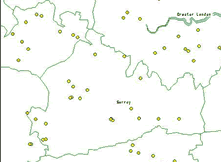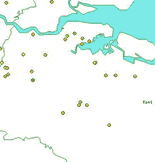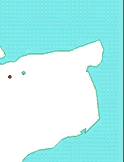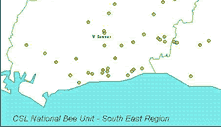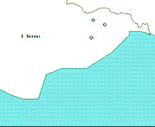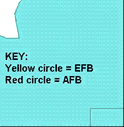South
East Region Foulbrood Incidence 2001
Please
find attached a map and report showing the distribution of confirmed foul
brood cases in the NBU South East Region in 2001.
Confirmed Foulbrood S.E Region
2001 [16 KB PDF Prints to 2 pages]
|
In 2001 bee inspectors inspected a total of 4233 colonies and 799 apiaries in the southeast region for disease, finding 281 cases of EFB and 2 cases of AFB. This is a high level of EFB compared with much of the rest of the England and Wales but paradoxically a significantly lower level of AFB. AFB has been an uncommon disease in our region for quite a number of years now. When is does occur it can be quite devastating in its effects. However, fortunately provided it is caught early and dealt with thoroughly, it generally proves not too difficult to eradicate from affected apiaries.
In contrast, EFB tends to be rather less damaging in its effects but harder to eradicate. Last year the counties worst affected by EFB (in terms of the number of infected colonies found) were West Sussex (103 cases), followed by Kent (76 cases), London (44 cases), Surrey (35 cases) and lastly East Sussex (23 cases).
However, if ranked by proportion of colonies examined found to have EFB, the ranking is somewhat different with West Sussex worst (12.1%), followed by Surrey (6.5%), London (6.4%), East Sussex (6.2%), and lastly Kent (4.3%). This may give a more realistic indication of the problem in the various counties as it takes into account differing numbers of inspections carried out by inspectors. However, these figures will tend to exaggerate the underlying incidence of disease since bee inspectors tend to concentrate on apiaries that they consider to be at particular risk of disease.
Of the colonies confirmed with EFB, 59% were treated by bee inspectors with antibiotic; 15% destroyed because they were too weak to respond to treatment; 13% destroyed because they were too heavily infected to respond to treatment; 9% destroyed at the owners request; and 5% destroyed because they had not responded to a previous treatment.
This year, many beekeepers in the southeast were involved in the EFB research studies that the NBU is currently carrying out. These included 'shook swarm' treatment and treatment with an experimental biological control agent ('PLP'). Both of these have potential as future alternatives to current controls for EFB, but more work to evaluate their efficacy is still required.
In the coming season, southeast region bee inspectors will be concentrating particularly on the worst affected areas to provide training, apiary inspections and disease control work to to help beekeepers identify and control foulbrood in their apiaries. We invite the involvement of beekeeping associations in helping to organise local 'apiary inspection tours' and bee-health talks and apiary demonstrations for their members. Please contact me for further details.
Further details of the NBUs apiary inspection programme and the incidence of foulbrood in England and Wales are available on the NBUs website
James Morton
South-Eastern
Regional Bee Inspector
Central Science Laboratory
National Bee Unit
Tel/fax: 020 8571 6450
Mobile: 07719 924 418
Email: j.morton@csl.gov.uk
Web: http://www.csl.gov.uk/prodserv/cons/bee/



